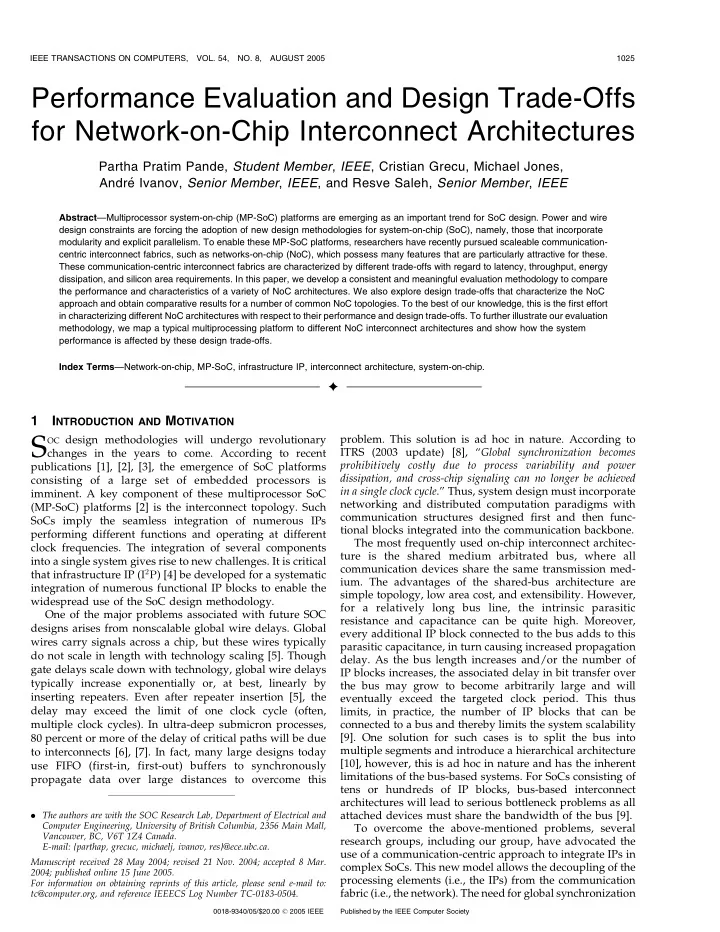

IEEE TRANSACTIONS ON COMPUTERS, VOL. 54, NO. 8, AUGUST 2005 1025 Performance Evaluation and Design Trade-Offs for Network-on-Chip Interconnect Architectures Partha Pratim Pande, Student Member , IEEE , Cristian Grecu, Michael Jones, Andre ´ Ivanov, Senior Member , IEEE , and Resve Saleh, Senior Member , IEEE Abstract —Multiprocessor system-on-chip (MP-SoC) platforms are emerging as an important trend for SoC design. Power and wire design constraints are forcing the adoption of new design methodologies for system-on-chip (SoC), namely, those that incorporate modularity and explicit parallelism. To enable these MP-SoC platforms, researchers have recently pursued scaleable communication- centric interconnect fabrics, such as networks-on-chip (NoC), which possess many features that are particularly attractive for these. These communication-centric interconnect fabrics are characterized by different trade-offs with regard to latency, throughput, energy dissipation, and silicon area requirements. In this paper, we develop a consistent and meaningful evaluation methodology to compare the performance and characteristics of a variety of NoC architectures. We also explore design trade-offs that characterize the NoC approach and obtain comparative results for a number of common NoC topologies. To the best of our knowledge, this is the first effort in characterizing different NoC architectures with respect to their performance and design trade-offs. To further illustrate our evaluation methodology, we map a typical multiprocessing platform to different NoC interconnect architectures and show how the system performance is affected by these design trade-offs. Index Terms —Network-on-chip, MP-SoC, infrastructure IP, interconnect architecture, system-on-chip. � 1 I NTRODUCTION AND M OTIVATION S OC design methodologies will undergo revolutionary problem. This solution is ad hoc in nature. According to ITRS (2003 update) [8], “ Global synchronization becomes changes in the years to come. According to recent prohibitively costly due to process variability and power publications [1], [2], [3], the emergence of SoC platforms dissipation, and cross-chip signaling can no longer be achieved consisting of a large set of embedded processors is in a single clock cycle .” Thus, system design must incorporate imminent. A key component of these multiprocessor SoC networking and distributed computation paradigms with (MP-SoC) platforms [2] is the interconnect topology. Such communication structures designed first and then func- SoCs imply the seamless integration of numerous IPs tional blocks integrated into the communication backbone. performing different functions and operating at different The most frequently used on-chip interconnect architec- clock frequencies. The integration of several components ture is the shared medium arbitrated bus, where all into a single system gives rise to new challenges. It is critical communication devices share the same transmission med- that infrastructure IP ( I 2 P ) [4] be developed for a systematic ium. The advantages of the shared-bus architecture are integration of numerous functional IP blocks to enable the simple topology, low area cost, and extensibility. However, widespread use of the SoC design methodology. for a relatively long bus line, the intrinsic parasitic One of the major problems associated with future SOC resistance and capacitance can be quite high. Moreover, designs arises from nonscalable global wire delays. Global every additional IP block connected to the bus adds to this wires carry signals across a chip, but these wires typically parasitic capacitance, in turn causing increased propagation do not scale in length with technology scaling [5]. Though delay. As the bus length increases and/or the number of gate delays scale down with technology, global wire delays IP blocks increases, the associated delay in bit transfer over typically increase exponentially or, at best, linearly by the bus may grow to become arbitrarily large and will inserting repeaters. Even after repeater insertion [5], the eventually exceed the targeted clock period. This thus delay may exceed the limit of one clock cycle (often, limits, in practice, the number of IP blocks that can be multiple clock cycles). In ultra-deep submicron processes, connected to a bus and thereby limits the system scalability 80 percent or more of the delay of critical paths will be due [9]. One solution for such cases is to split the bus into multiple segments and introduce a hierarchical architecture to interconnects [6], [7]. In fact, many large designs today [10], however, this is ad hoc in nature and has the inherent use FIFO (first-in, first-out) buffers to synchronously limitations of the bus-based systems. For SoCs consisting of propagate data over large distances to overcome this tens or hundreds of IP blocks, bus-based interconnect architectures will lead to serious bottleneck problems as all . The authors are with the SOC Research Lab, Department of Electrical and attached devices must share the bandwidth of the bus [9]. Computer Engineering, University of British Columbia, 2356 Main Mall, To overcome the above-mentioned problems, several Vancouver, BC, V6T 1Z4 Canada. research groups, including our group, have advocated the E-mail: {parthap, grecuc, michaelj, ivanov, res}@ece.ubc.ca. use of a communication-centric approach to integrate IPs in Manuscript received 28 May 2004; revised 21 Nov. 2004; accepted 8 Mar. complex SoCs. This new model allows the decoupling of the 2004; published online 15 June 2005. processing elements (i.e., the IPs) from the communication For information on obtaining reprints of this article, please send e-mail to: fabric (i.e., the network). The need for global synchronization tc@computer.org, and reference IEEECS Log Number TC-0183-0504. 0018-9340/05/$20.00 � 2005 IEEE Published by the IEEE Computer Society
Recommend
More recommend